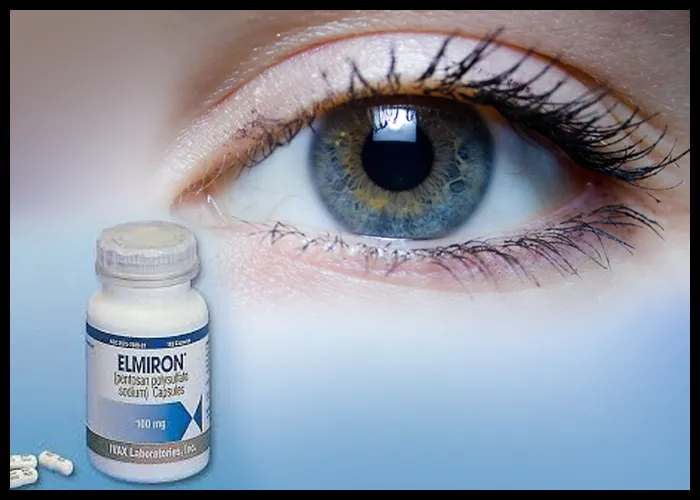Elmiron is a popular drug manufactured by Janssen Pharmaceuticals. Elmiron® is known scientifically as pentosan polysulfate sodium (PPS). It is used to treat interstitial cystitis, a urinary tract condition that causes pain in the abdomen, pelvic, and genital regions. The condition may also lead to frequent urination. For those with chronic symptoms, Elmiron is often prescribed for extended periods of time. Elmiron is also sometimes used to treat osteoarthritis.
In 2018, an article by the American Academy of Ophthalmology revealed that several patients had been diagnosed with retinal maculopathy after being treated with Elmiron for interstitial cystitis. This rare but serious eye disease alters pigment cells in the retina, changing the eye color while causing significant eye damage and vision loss. It is often mistaken for a similar condition called macular degeneration.
Symptoms for patients experiencing Elmiron-associated eye damage include:
- Change in eye color (these may be small spots of color changes in the iris – the colored part of the eye)
- Blurred vision (often centrally in the person’s field of vision)
- Difficulty reading
- Dark spots in center of vision
- Difficulty adapting to dim lighting
- Straight lines appearing curved or squiggly
- Less vivid colors
In December 2019, the Interstitial Cystitis Network conducted a survey of its members taking Elmiron. More than half of the patients taking Elmiron who participated in the survey suffered from retinal disease. Yet, the Elmiron packaging contained no warnings whatsoever about adverse effects. Amid increasing pressure from both the medical community and lawsuits from victims, Janssen is now acknowledging Elmiron’s association with serious eye injury and vision complications. In June of 2020, Elmiron’s label was modified to include new warnings for retinal pigmentary changes, including pigmentary maculopathy.
Litigants allege that that manufacturer has known of the risk of eye injury associated with the drug for many years, but failed to take any action to warn doctors or consumers.
Critical portions of the new warnings are as follows:
- Retinal Pigmentary Maculopathy Pigmentary changes in the retina, reported in the literature as pigmentary maculopathy, have been identified with long-term use of ELMIRON® (see ADVERSE REACTIONS).
- Although most of these cases occurred after 3 years of use or longer, cases have been seen with a shorter duration of use.
- While the etiology is unclear, cumulative dose appears to be a risk factor.
- Visual symptoms in the reported cases included difficulty reading, slow adjustment to low or reduced light environments, and blurred vision. The visual consequences of these pigmentary changes are not fully characterized.
- Caution should be used in patients with retinal pigment changes from other causes in which examination findings may confound the appropriate diagnosis, follow-up, and treatment.
- Detailed ophthalmologic history should be obtained in all patients prior to starting treatment with ELMIRON®.
- If there is a family history of hereditary pattern dystrophy, genetic testing should be considered.
- For patients with pre-existing ophthalmologic conditions, a comprehensive baseline retinal examination (including color fundoscopic photography, ocular coherence tomography (OCT), and auto-fluorescence imaging) is recommended prior to starting therapy. A baseline retinal examination including OCT and auto-fluorescence imaging) is suggested for all patients within six months of initiating treatment and periodically while continuing treatment.
- If pigmentary changes in the retina develop, then risks and benefits of continuing treatment should be re-evaluated, since these changes may be irreversible. Follow-up retinal examinations should be continued given that retinal and vision changes may progress even after cessation of treatment.
In addition to the symptoms set forth in the new warnings, patients have also reported other visual symptoms including dark spots in central vision, straight lines appearing curved or squiggly, and muted, less vivid colors.
It is important that any patient using Elmiron clearly understand the risks to their vision before taking the drug. For patients who already have pre-existing retinal changes prior to taking Elmiron the warning is clear that doctors and patients should exercise extra caution. Prescribers should review eye-related medical records prior to starting a patient on Elmiron.
Because pattern dystrophy, age-related macular degeneration (AMD) and other retinal diseases are often linked to genetic predisposition, those with family history are advised to consider genetic testing. For those found to have genetic predisposition to these conditions (from testing), it may be even less desirable for them to take a drug associated with an increased risk for vision problems.
The warning advise Elmiron patients to get specific retinal imaging exams. For those with a pre-existing ophthalmologic condition, they are advised to get a baseline retinal exam prior to starting the drug. For those without a pre-existing ophthalmologic condition, they recommend a baseline retinal exam within six (6) months of starting treatment. It may be preferable for all patients to get a baseline retinal exam before starting Elmiron so that any subsequent decline in vision can be properly assessed. We suggest that before starting Elmiron, patients consult with both the prescribing doctor and an ophthalmologist about the potential risk for eye damage and vision loss. If you are presently taking Elmiron, we suggest that you visit your ophthalmologist as soon as possible and ask for the testing outlined in the warning label. It is believed that Elmiron causes long term damage. Elmiron-associated maculopathy may be irreversible, even after discontinuing use.
If you or a loved one has used Elmiron and are concerned about vision loss or damage, the personal injury attorneys at Lacy Katzen LLP may be able to help. Please contact attorney Jacqueline Thomas for a free consultation.


